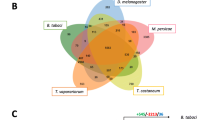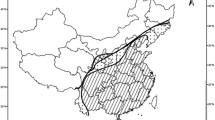Abstract
Temperature is a primary factor that determines geographic insect boundaries and population developments. Insect responses to temperature stress are particularly important in invasive species. Bemisia tabaci is a genetic complex of closely related whiteflies. Invasive and indigenous species were used to test genotype responses to temperature stress. To determine whether thermal tolerance is related to differential expression of heat shock proteins (hsp) under temperature stress in two invasive and native sibling species, commonly referred to as the biotype B and biotype Q of B. tabaci, we analyzed the expression profiles of hsp90 and hsp70 and hsp20 across temperature gradients using real-time quantitative polymerase chain reaction. The B. tabaci invasive species Q is more tolerant to short temperature stress than the indigenous species ZHJ1, and the onset (Ton) or maximal (Tmax) temperature induction of hsp expression in the B. tabaci invasive species Q was generally 2–4°C higher than that found in the indigenous species ZHJ1. Our results demonstrate differences in gene expression between these closely related and sympatric B. tabaci sibling species, suggesting that these differences account for the better adaptation of invasive species over indigenous species. These differences may eventually lead to changes in the local and global distribution of both species in a warmer world.



Similar content being viewed by others
References
Boykin LM, Shatters RG, Rosell RC, McKenzie CL, Bagnall RA, De Barro PJ, Frohlich DR (2007) Global relationships of Bemisia tabaci (Hemiptera: Aleyrodidae) revealed using Bayesian analysis of mitochondrial COI DNA sequences. Mol Phylogenet Evol 44:1306–1319
Brown JK (2000) Molecular markers for the identification and global tracking of whitely vector-begomovirus complexes. Virus Res 71:233–260
Buckley BA, Owen ME, Hofmann GE (2001) Adjusting the thermostat: the threshold induction temperature for the heat shock response in intertidal mussels (genus Mytilus) changes as a function of thermal history. J Exp Biol 204:3571–3579
Chu D, Zhang YJ, Brown JK, Cong B, Xu BY, Wu QJ, Zhu GR (2006) The introduction of the exotic biotype Q of Bemisia tabaci from the Mediterranean region into China on ornamental crops. Fla Entomol 89:168–174
De Barro PJ, Bourne A (2010) Change in oviposition choice by an invader to avoid competition accelerates the displacement of a competitor. Biol Invasions 12:3013–3023
De Barro PJ, Liu SS, Boykin LM, Dinsdale AB (2011) Bemisia tabaci: a statement of species status. Annu Rev Entomol 56:1–19
Delatte H, Duyck PF, Triboire A, David P, Becker N, Bonato O, Reynaud B (2009) Differential invasion success among biotypes: case of Bemisia tabaci. Biol Invasions 11:1059–1070
Feder ME, Hofmann GE (1999) Heat shock proteins, molecular chaperones, and the stress response: evolutionary and ecological physiology. Annu Rev Physiol 61:243–282
Frydenberg J, Hoffmann AA, Loeschcke V (2003) DNA sequence variation and latitudinal associations in hsp23, hsp26 and hsp27 from natural populations of Drosophila melanogaster. Mol Ecol 12:2025–2032
Garbuz D, Evgenev MB, Feder ME, Zatsepina OG (2003) Evolution of the thermotolerance and heat-shock response: evidence from inter/intra-specific comparison and interspecific hybridization in the virilis species group of Drosophila. J Exp Biol 206:2392–2408
Gehring WJ, Werner R (1995) Heat shock protein synthesis and thermotolerance in Cataglyphis, an ant from the Sahara desert. Proc Natl Acad Sci USA 92:2994–2998
Henkel SK, Hofmann GE (2008) Differing patterns of hsp70 gene expression in invasive and native kelp species: evidence for acclimation-induced variation. J Appl Phycol 20:915–924
Hoffmann AA, Sorensen JG, Loeschcke V (2003) Adaptation of Drosophila to temperature extremes: bringing together quantitative and molecular approaches. J Therm Biol 28:175–216
Hu J, De Barro P, Zhao H, Wang J, Nardi F, Liu SS (2011) An extensive field survey combined with a phylogenetic analysis reveals rapid and widespread invasion of two alien whiteflies in China. PLoS One 6(1):e16061
Huang LH, Kang L (2007) Cloning and interspecific altered expression of heat shock protein genes in two leafminer species in response to thermal stress. Insect Mol Biol 16:491–500
Intergovernmental Panel on Climate Change (2007) IPCC fourth assessment report, climate change 2007. Working group I report. The physical science basis. Cambridge University Press, Cambridge, pp 747–845
Jiu M, Zhou XP, Tong L, Xu J, Yang X, Liu SS, Wan FH (2007) Vector-virus mutualism accelerates population increase of an invasive whitefly. PLoS One 2(1):e182
Li ZX (2006) Molecular phylogenetic analysis reveals at least five genetic races of Bemisia tabaci in China. Phytoparasitica 34:431–440
Liu SS, De Barro PJ, Xu J, Luan JB, Zang LS, Ruan YM, Wan FH (2007) Asymmetric mating interactions drive widespread invasion and displacement in a whitefly. Science 318:1769–1772
Lü ZC, Wan FH (2011) Using double-stranded RNA to explore the role of heat shock protein genes in heat tolerance in Bemisia tabaci (Gennadius). J Exp Biol 214:764–769
Lund SG, Ruberte MR, Hofmann GE (2006) Turning up the heat: the effects of thermal acclimation on the kinetics of hsp70 gene expression in the eurythermal goby, Gillichthys mirabilis. Comp Biochem Physiol A 143:435–446
Morimoto RI (1998) Regulation of the heat shock transcriptional response: crosstalk between a family of heat shock factors, molecular chaperones, and negative regulators. Genes Dev 12:3788–3796
Nann AF, Myriam H, Patricia MS (2006) Intraspecific variation in thermal tolerance and heat shock protein gene expression in common killifish, Fundulus heteroclitus. J Exp Biol 209:2859–2872
Parsell DA, Lindquist S (1993) The function of heat shock proteins in stress tolerance: degradation and reactivation of damaged proteins. Annu Rev Genet 27:437–496
Sax DF, Stachowicz JJ, Brown JH, Bruno JF, Dawson MN, Gaines SD, Grosberg RK, Hastings A, Holt RD, Mayfield MM, O’Connor MI, Rice WR (2007) Ecological and evolutionary insights from species invasions. Trends Ecol Evol 22:465–471
Somero GN (2005) Linking biogeography to physiology: evolutionary and acclamatory adjustments of thermal limits. Front Zool 2:1–9
Tomanek L, Somero GN (1999) Evolutionary and acclimation induced variation in the heat shock responses of congeneric marine snails (genus Tegula) from different thermal habitats: implications for limits of thermotolerance and biogeography. J Exp Biol 202:2925–2936
Voisin M, Engel CR, Viard F (2005) Differential shuffling of native genetic diversity across introduced regions in a brown alga: aquaculture vs. maritime traffic effects. Proc Natl Acad Sci USA 102:5432–5437
Wan FH, Zhang GF, Liu SS, Luo C, Chu D, Zhang YJ, Zang LS, Jiu M, Lu ZC, Cui XH, Zhang LP, Zhang F, Zhang QW, Liu WX, Liang P, Lei ZR, Zhang YJ (2009) Invasive mechanism and management strategy of Bemisia tabaci (Gennadius) biotype B: progress report of 973 program on invasive alien species in China. Sci in China Series C Life Sci 52:88–95
Wu C (1995) Heat shock transcription factors: structure and regulation. Annu Rev Cell Dev Biol 11:441–469
Xu Q, Wang WL, Liu SS (2006) Occurrence of Q biotype Bemisia tabaci in some areas of Zhejing. Plant Prot 32(4):121
Yu H, Wan FH (2009) Cloning and expression of heat shock protein genes in two whitefly species in response to thermal stress. J Appl Entomol 133:602–614
Zang LS, Liu SS (2007) A comparative study on mating behaviour between the B biotype and a non-B biotype of Bemisia tabaci (Hemiptera: Aleyrodidae) from Zhejiang, China. J Insect Behav 20:151–171
Zang LS, Liu SS, Liu YQ, Ruan YM, Wan FH (2005) Competition between the B biotype and a non-B biotype of the whitefly, Bemisia tabaci (Homoptera: Aleyrodidae) in Zhejiang, China. Biodivers Sci 13:181–187
Acknowledgments
We appreciate the helpful comments provided by the anonymous reviewers. This work was supported by the National Basic Research and Development Program (Grant No. 2009CB119200) and National Natural Science Foundation of China (No.30800722), Ministry of Science and Technology, China.
Author information
Authors and Affiliations
Corresponding author
Electronic supplementary material
Below is the link to the electronic supplementary material.
Rights and permissions
About this article
Cite this article
Yu, H., Wan, F.H. & Guo, J.Y. Different thermal tolerance and hsp gene expression in invasive and indigenous sibling species of Bemisia tabaci . Biol Invasions 14, 1587–1595 (2012). https://doi.org/10.1007/s10530-012-0171-7
Received:
Accepted:
Published:
Issue Date:
DOI: https://doi.org/10.1007/s10530-012-0171-7




